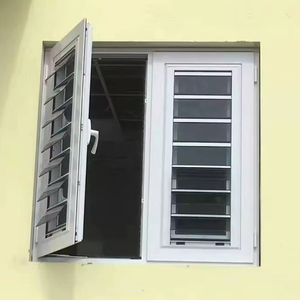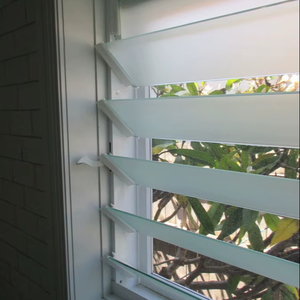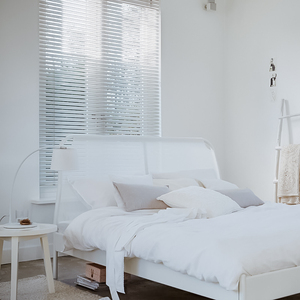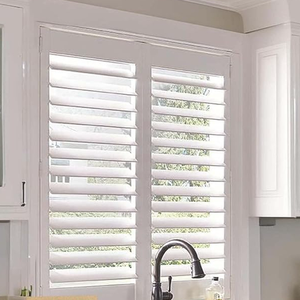(3194 products available)





































































































































































































PVC louvres are also known as PVC louver doors. These are doors with slats that can open and shut. They are made of polyvinyl chloride (PVC) material. PVC is a durable and long-lasting material. It won't rust, rot, or get eaten by insects.
There are different kinds of PVC louvres. They include:
PVC louvres are versatile and functional elements used in construction and home improvement to provide ventilation, natural light, and aesthetic appeal. Here are some key features and functions:
Ventilation:
Airflow Control: PVC louvres can be adjusted to control the amount of air entering a space. This helps in regulating ventilation and maintaining a comfortable environment. PVC louvres are installed in windows or walls to allow air circulation. This prevents moisture buildup and improves indoor air quality.
Natural Light:
Light Influx: PVC louvres are designed to allow natural light to enter a room while minimizing glare. This creates a well-lit and pleasant indoor atmosphere. PVC louvres are positioned at an angle to direct natural light into the room. This reduces the need for artificial lighting during the day.
Temperature Regulation:
Heat Reduction: By adjusting the angle of the slats, PVC louvres can regulate the amount of sunlight entering a space. This helps to keep indoor temperatures cool and comfortable, especially in warm climates. PVC louvres are used to ventilate spaces like attics and roofs. This prevents heat buildup and reduces reliance on air conditioning systems.
Privacy and Security:
Concealment: Closed or partially closed PVC louvres provide privacy by preventing outsiders from seeing into the space. This is particularly important for windows and doors in residential and commercial properties. Strength: High-quality PVC louvres are durable and resistant to corrosion, UV rays, and extreme weather conditions. This ensures that they maintain their functionality and appearance over time.
Design and Aesthetics:
Variability: PVC louvres come in different designs, sizes, and colors to suit various architectural styles and preferences. They can be customized to fit specific requirements. PVC louvres add a stylish touch to a building's exterior and interior. This enhances the overall aesthetic appeal of the space.
Energy Efficiency:
Reduced Cooling Costs: Properly installed and adjusted PVC louvres can reduce the need for air conditioning. This leads to lower energy bills and a smaller carbon footprint. Natural Ventilation: PVC louvres facilitate natural ventilation by allowing cool outdoor air to enter and warm air to escape. This reduces the need for mechanical cooling systems.
There are various applications for PVC louvres in residential and commercial settings. These include:
There are several factors to consider when choosing the PVC louvre design, including:
Climate:
Consider the local climate. If it is a region with heavy rain or strong winds, choose shutters that can withstand severe weather, like PVC or vinyl material. PVC louvres have high resistance to corrosion and moisture, making them suitable for rainy areas. They are also durable and provide optimum protection against harsh weather conditions.
Location:
For coastal areas, select louvres that can endure saltwater exposure. As mentioned, PVC is perfect for this location due to its weather-resistant properties. If the location is prone to extreme temperatures, opt for insulated louvres or materials with high insulation properties.
Aesthetic consideration:
The PVC louvre design and color should complement the building's architectural style and interior decor. Choose from the available frame styles, including classic, modern, and decorative. Also, consider the finish options, like smooth or textured. More importantly, consider the room in which the louvres will be installed. For example, if it's a living area, opt for louvres that offer a perfect balance of privacy and airflow.
Budget:
While PVC and vinyl are cost-effective, they provide excellent value, outperforming traditional materials in long-term durability and maintenance. PVC louvres usually come in various price ranges, so choose one that meets the budgetary needs without compromising quality.
Maintenance:
Consider the amount of time and effort willing to devote to louvre maintenance. Opt for low-maintenance PVC louvres if prefer minimal upkeep. These louvres require little to no painting and are resistant to rot.
Privacy and security:
For areas requiring high privacy and security, choose louvre designs with tighter slats and stronger locking mechanisms. PVC louvres are a great choice, as they offer high resistance to damage and robust construction, ensuring optimal security.
Q1: Are PVC louvres more cost-effective than traditional materials?
A1: PVC is generally more affordable than materials like aluminum and wood. PVC louvres provide a great balance between cost and performance. They are among the most affordable options for homeowners looking to enhance their homes without breaking the bank.
Q2: Can PVC louvres be customized to fit specific requirements?
A2: PVC louvres are highly versatile and can be customized to fit different styles and preferences. They come in different colors, sizes, and finishes that can be tailored to fit individual needs.
Q3: Are PVC louvres suitable for coastal areas?
A3: Absolutely. PVC is resistant to corrosion, making it perfect for coastal areas where saltwater poses a threat to other materials. PVC louvres will offer long-lasting performance in coastal environments.